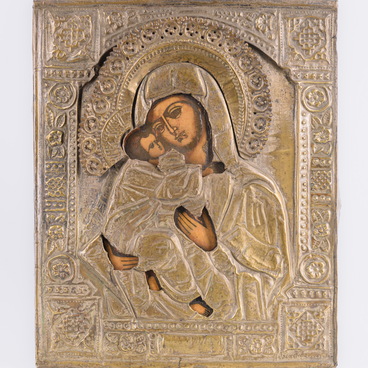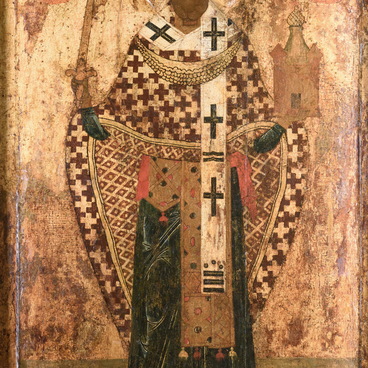The iconography of the image “Joy of All Who Sorrow” (or “Joy to All Who Suffer”) was formed in the 17th century. In the early versions (they are very different from the later ones), the motifs of the Western European school are clearly evident. The image of the Virgin with Jesus in her arms, surrounded by angels and without figures of the suffering, is compared with “Madonna in Glory” (Gloria); the presence of rosaries is a reference to the “Rosary” (Rosarium), or “Vision of St. Dominic”. In addition, there was an iconographic type “The Image of Tenderness and Visiting the Suffering” (over time, this type and the “Joy of All Who Sorrow” merged together), which is compared to the image “The Lady of Mercy” (Misericordia).
It is believed that the first icon of “Joy” was painted in 1683 by Ivan Bezmin, an artist who created Western-style paintings at the court.
The image is known in many versions: in some of them the Virgin is represented alone, on others — together with the Christ Child; in her hands she can hold a scroll, a flowering branch, bread, or her hands can be free; Mary’s feet can rest on the moon or a rainbow, and so on.
The figures of the suffering became part of the composition after 1688, when the image was recognized as miraculous. Euphemia, the sister of Patriarch Joachim of Moscow, a parishioner of the Transfiguration Church on Ordynka, was healed from a deadly disease through her prayers to the image. A legend of the miracle and prayers to the miraculous icon were compiled, and its copies began to appear.
According to legend, many were healed also in front of the icon, found in the 19th century on the banks of the Neva River by the merchant Kurakin.
The presented icon comes from the Nativity Church in the town of Balakhna. It partly resembles the “Orans” type, but differs in a number of features. The main idea is the representation of the Mother of God as the Intercessor and Helper of all those who come to her. The figure of the Mother of God, significantly larger than the others, is enclosed in a shining mandorla-sun; Mary tilts her head to her right shoulder, turning her gaze to the people and covering them with her hands and the hem of the maphorion. Angels comfort the suffering in the name of the Virgin: one shelters the naked, some heal the sick, and others give food to the hungry. Above the whole composition in the clouds is a half-length image of Christ.
The face and hands are modeled with chiaroscuro, which makes them look three-dimensional. The colors of the clothes of the Virgin and the Savior are traditional for these images.
The icon has been housed in the Balakhna Museum since February 28, 1977. In 1991, the artifact was restored by Valery Fyodorovich Kosushkin at the Interregional Scientific and Restoration Art Department. In 2019, secondary restoration works were carried out by the staff of the Ilya Glazunov Russian Academy of Painting, Sculpture and Architecture.
It is believed that the first icon of “Joy” was painted in 1683 by Ivan Bezmin, an artist who created Western-style paintings at the court.
The image is known in many versions: in some of them the Virgin is represented alone, on others — together with the Christ Child; in her hands she can hold a scroll, a flowering branch, bread, or her hands can be free; Mary’s feet can rest on the moon or a rainbow, and so on.
The figures of the suffering became part of the composition after 1688, when the image was recognized as miraculous. Euphemia, the sister of Patriarch Joachim of Moscow, a parishioner of the Transfiguration Church on Ordynka, was healed from a deadly disease through her prayers to the image. A legend of the miracle and prayers to the miraculous icon were compiled, and its copies began to appear.
According to legend, many were healed also in front of the icon, found in the 19th century on the banks of the Neva River by the merchant Kurakin.
The presented icon comes from the Nativity Church in the town of Balakhna. It partly resembles the “Orans” type, but differs in a number of features. The main idea is the representation of the Mother of God as the Intercessor and Helper of all those who come to her. The figure of the Mother of God, significantly larger than the others, is enclosed in a shining mandorla-sun; Mary tilts her head to her right shoulder, turning her gaze to the people and covering them with her hands and the hem of the maphorion. Angels comfort the suffering in the name of the Virgin: one shelters the naked, some heal the sick, and others give food to the hungry. Above the whole composition in the clouds is a half-length image of Christ.
The face and hands are modeled with chiaroscuro, which makes them look three-dimensional. The colors of the clothes of the Virgin and the Savior are traditional for these images.
The icon has been housed in the Balakhna Museum since February 28, 1977. In 1991, the artifact was restored by Valery Fyodorovich Kosushkin at the Interregional Scientific and Restoration Art Department. In 2019, secondary restoration works were carried out by the staff of the Ilya Glazunov Russian Academy of Painting, Sculpture and Architecture.



